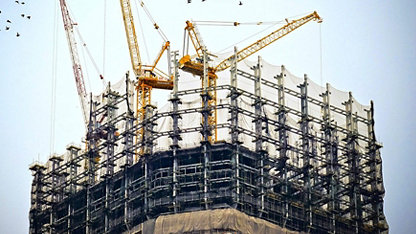The impact of the coronavirus outbreak in the UK and globally has been severe and wide-ranging. In January 2020, both the UK Department of Health and Social Care and Public Health England assessed the risk as low; however, by 10 February, The Health Protection (Coronavirus) Regulations 2020 had been published, and the government declared that there was a serious and imminent threat to public health, leading to the first stage of the lockdown being announced on 16 March.
Between these dates, from 8 February to 19 February 2020, large parts of the UK were devastated by Storm Ciara and Storm Dennis, and we were contemplating the effects of widespread flooding. So maybe we all had our minds on something else?
The impact of the pandemic on all business sectors has been dramatic, but construction has been particularly affected, and given that it represents a significant part of the UK’s economic output, there could be serious consequences.
On 13 May, the Minister for Housing announced the intention to allow more flexible construction site working hours in England. Local Planning Authorities were directed to look sympathetically on applications for extended hours, initially up to 9pm, but in some cases to permit 24-hour working.
It is hoped that this proposal will help mitigate delays to overall construction programmes and make it easier to follow industry health and safety guidance on site operations, such as social distancing and the separation of activities, while different start and finish times for workers could also reduce the pressure on public transport.
Throughout the pandemic, some construction work has continued, and notable projects such as the Nightingale field hospitals have been designed, constructed and opened in record time – an example of what can be achieved when the industry pulls together.
For the remainder, the outlook is that work will probably be delayed, some of it significantly. Whether this is because of labour or material shortages, changes in working practices to accommodate new social distancing rules, or simply the non-availability of sites or working areas – either due to government intervention or self-isolation of the potential occupants – it is clear that many projects will not be completed within the timeframe anticipated when contracts were originally signed.
There is a wealth of advice issued by government, professional institutions, contract publishers and industry groups on issues like procurement, rules for travel, working environments and personal health and safety, and this should all be read carefully. The Construction Leadership Council has issued guidance on site operating procedures, for example, but this has already been updated several times, so it is important to ensure the latest version is being followed.
When construction work is delayed or disrupted, it is not uncommon for people to look to their contractual arrangements for a solution. This is a perfectly reasonable approach – assuming you remembered to record and sign them in the first place.
Standard form construction contracts will typically have a mechanism for dealing with these eventualities, but it would be a mistake to assume that they are all the same. In fact, there can be considerable differences between contracts, even those in the same family or from the same publisher, and this is before amendments have been made which could change the balance of risk, and the procedures for assessing and implementing them.
“Standard form construction contracts will typically have a mechanism for dealing with delays or disruptions, but it would be a mistake to assume that they are all the same. ”
What are the options?
It is tempting in light of unprecedented disruption and uncertainty for each party to see how the contract can be interpreted to give them the best outcome. This may be understood, on one hand, as minimising possible exposure to delay damages for a contractor or subcontractor, or by keeping any time extension as short as possible for an employer or client.
But is that really the best option for all concerned? One thing that is generally agreed is that the outbreak itself is not the fault of either party to the work. It is a reasonable assumption, therefore, that the principal objective – to get the work completed – remains a priority, and this is likely still shared across all project stakeholders.
It is likely that priorities will have changed since the outbreak began. Employers may be debating whether to continue at the same pace while their cash flow is disrupted. Contractors may be thinking about carrying on while potentially being unable to meet their commitments due to shortages of labour or materials, or concerns about the safety of their employees. Prospective tenants may no longer be committed to the anticipated occupation date.
In a world where collaboration and alliancing have been buzzwords for over two decades, what better time to demonstrate a commitment to this ethos by getting together in that spirit of mutual trust and cooperation, and add value to the project using innovation, to the benefit of all concerned.
“In a world where collaboration and alliancing have been buzzwords for over two decades, what better time to demonstrate a commitment to this ethos by getting together in that spirit of mutual trust and cooperation. ”
Contracts published by JCT, NEC, FIDIC, RIBA and others all contain measures designed to foster collaboration and the intention is clear; try to find a solution, while taking steps to mitigate the problem.
However, there are some contractual procedures to observe. The precise detail of each one will be set out in the contract itself. Failure to observe these contractual procedures might weaken one party’s position, but the main effect will be to cause confusion.
Some key things to look out for include the following:
Early Warning
NEC and FIDIC contracts contain explicit provisions regarding early warning of events which may materially affect the progress of the work. JCT and RIBA contracts are perhaps less specific, but still have the same intention. However, there may be some debate about when it became obvious that the coronavirus outbreak would cause the levels of disruption that it has. The disease is referred to as COVID-19, because it was first encountered in 2019, even though the name was not formally announced by the World Health Organisation until 11 February 2020. So, when was it reasonably practicable to believe that it would materially affect construction work?
Extension of time and delay costs
Most contracts have provision for things which happen during the contract and trigger access to additional time or money. Usually they contain a list of compensation events or relevant events which may justify adjustment of one or both. One of these items is usually described as something ‘which neither party could foresee or prevent’. This is sometimes referred to by commentators as force majeure.
Although NEC does not use this terminology, JCT lists force majeure as being a relevant event, but without a precise definition. RIBA building contracts contain a description, while FIDIC changed the wording in their 2017 suite to an ‘exceptional event’. Interpretation will often depend on the wording and circumstances.
The list of events may also include things like the inability to secure labour or materials, prevention of access to the site of the works, or changes to legislation. These events might also be cited as reasons for terminating the contract, or frustration – the position at common law where it is not possible to complete the work at all – so it is easy to see how important it is to read the terms carefully.
Insurance
There are a number of insurance policies that can be applied to a project. Again, the unamended standard forms typically have a list, together with the option of setting out who is responsible for arranging the cover, but most also include the facility to add further items. It is possible that cover has been required for the consequences of delays and disruption or the parties might individually have business interruption insurance, that covers them in the eventuality that their trading position is affected. Once more, it is vital to check the precise wording, and take specialist advice where appropriate.
Variation
As noted earlier, for every situation, there are usually two types of solution; the literal one, that follows the letter of the contract – once it has been determined what that is – and there is lots of commentary online regarding potential legal responses. But there may also be a practical solution, sorted out over a cup of tea on video conference, if that is more suitable.
Most contracts empower the person administering it to issue instructions, which, among other things, allow them to change the kind, quality or sequence of the work, although in practice this would always be done following discussion. In addition, the parties to the contract have the freedom to vary the terms of the contract itself. It may be that the work can continue to be carried out, but in a different sequence, or that parts of it can be completed in isolation, while others are deferred until materials can be sourced.
The current situation will end at some point, and it is essential for future relationships, both business and personal, that an amicable conclusion is found. In any event, if work carries on, there should be a revised set of site rules, which are compliant with government advice and instructions.
How to proceed with any construction project will depend on three main things: the intention of the parties, the wording of the contract, and ultimately the relationship between them. It is perhaps worth pointing out that one situation will apply to current contracts, but for those that have yet to be signed, the position will be different. Coronavirus is no longer unforeseen, so will possibly not be recognised as a force majeure event.
The most important thing to do right now is to talk – something our industry isn’t necessarily known for, but now is a perfect opportunity to demonstrate our flexibility and innovation.
- Roland Finch FRICS is a technical author at the NBS roland.finch@thenbs.com















